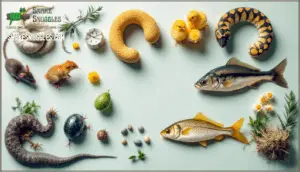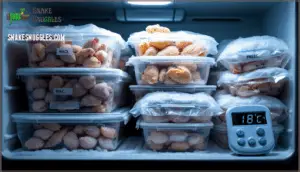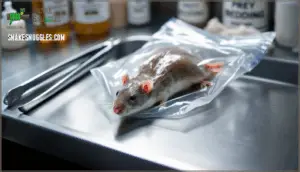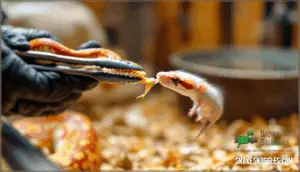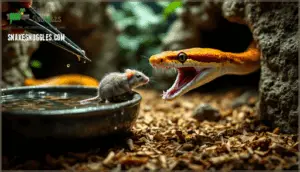This site is supported by our readers. We may earn a commission, at no cost to you, if you purchase through links.
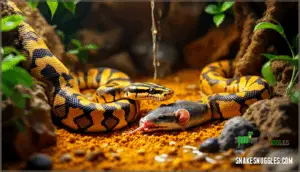 A ball python that refuses food for three months isn’t necessarily sick—it might just be following its natural metabolic calendar. Your snake’s feeding schedule depends on its species, age, size, and even the ambient temperature in its enclosure, not some one-size-fits-all chart you found online.
A ball python that refuses food for three months isn’t necessarily sick—it might just be following its natural metabolic calendar. Your snake’s feeding schedule depends on its species, age, size, and even the ambient temperature in its enclosure, not some one-size-fits-all chart you found online.
Hatchlings burn through nutrients fast and need weekly meals, while adult boas can thrive on monthly feedings without losing condition. Getting this balance right prevents regurgitation, obesity, and the stress of force-feeding a satiated animal.
The best snake feeding schedule accounts for your specific reptile’s physiology and mirrors the boom-and-bust cycles they’ve evolved to manage.
Table Of Contents
- Key Takeaways
- Creating The Ideal Snake Feeding Schedule
- Choosing The Right Prey for Your Snake
- Live Vs. Frozen-Thawed Prey Options
- Feeding Techniques and Best Practices
- Avoiding Common Snake Feeding Mistakes
- Frequently Asked Questions (FAQs)
- How often should you feed a snake?
- How do you feed a snake a healthy diet?
- Should snakes be fed based on age and size?
- When is the best time to feed a snake?
- Do snakes need a balanced feeding schedule?
- What size prey should a snake eat?
- What supplements do pet snakes need regularly?
- Can snakes eat eggs as primary food?
- How long can snakes safely go without eating?
- Do different snake colors affect feeding schedules?
- Conclusion
Key Takeaways
- Snake feeding schedules depend on species, age, size, and metabolic rate—hatchlings need weekly meals while adult snakes thrive on monthly feedings, so you’ll avoid obesity and regurgitation by matching intervals to your snake’s specific biology rather than following generic timelines.
- Frozen-thawed prey eliminates the 20% bite injury risk and 13-22% parasite transmission rate associated with live feeding, making it the safer choice that also allows for convenient bulk storage and more humane dispatch methods.
- Prey size should match roughly 10% of your snake’s body weight and not exceed 1.5 times its widest body diameter, because oversized meals cause regurgitation and stress while proper sizing supports healthy digestion and prevents metabolic complications.
- Regular weight monitoring every 2-4 weeks combined with detailed feeding logs transforms guesswork into precision, helping you detect nutritional deficiencies, obesity risks, or health issues before they become serious problems that compromise your snake’s wellbeing.
Creating The Ideal Snake Feeding Schedule
Getting your snake’s feeding schedule right isn’t guesswork—it’s about understanding the biological factors that drive their nutritional needs. Several variables come into play, from metabolic rate to reproductive status, and each one shapes how often your snake should eat.
Let’s break down the key considerations that’ll help you build a feeding plan adapted to your snake’s specific requirements.
Factors Affecting Feeding Frequency
Because feeding frequency depends on multiple interconnected variables, you’ll need to factor in species variation, your snake’s age, metabolic rate, health status, temperature regulation, and prey size.
Different snake species evolved distinct foraging strategies—ambush hunters like ball pythons consume larger meals less frequently, while active foragers require more regular feeding.
Metabolism accelerates with ideal temperatures (85–90°F), shortening intervals between meals, and younger snakes demand more frequent feedings due to rapid growth phases.
For ball pythons, it’s important to remember that rats are nutritious and suitable prey.
Feeding Frequency by Age and Size
Once you understand those broader variables, you can establish age-based intervals that support peak growth and metabolism. Hatchling feeding demands consistency—every 5–7 days with appropriately sized prey items. As juvenile snakes mature, you’ll extend intervals to 7–10 days while increasing prey size proportionally. Sub-adult frequency shifts to 10–14 days, and adult snakes thrive on 10–21 day cycles. Snakes, being carnivores, require species-specific diets to thrive.
Here’s what matters most:
- Hatchlings grow fastest—missing even one feeding window can stunt development permanently
- Juvenile schedules demand precision—irregular meals during this phase create lifelong metabolic issues
- Size-based adjustments protect your snake—prey that’s too large causes regurgitation and stress
- Adult intervals require restraint—overfeeding mature snakes is the most common husbandry mistake you’ll make
Adjusting for Breeding and Health
When breeding season approaches or health issues arise, your carefully calibrated feeding routine needs immediate recalibration—reproductive demands and recovery protocols don’t follow standard metabolic rules. Gravid females require increased feeding pre-breeding, while males often refuse food entirely during breeding season.
During shedding cycles and brumation periods, appetite loss is normal—don’t force-feed. If snake health issues persist beyond typical patterns, consult your reptile vet immediately.
Weight monitoring reveals whether metabolic rate changes demand schedule adjustments.
Monitoring and Record-Keeping
Tracking every meal, weight change, and feeding response in a dedicated log transforms guessing into precision—your records become the clearest window into your snake’s true metabolic patterns. Document Weight Tracking and Behavior Logging consistently, noting prey size, refusals, and aggression levels.
Shedding Records and Hydration Monitoring reveal correlations between feeding schedules and physiological cycles, while Supplement Tracking guarantees nutritional completeness.
This data-driven approach to weight management allows you to fine-tune your feeding schedule based on actual snake health indicators rather than assumptions.
Choosing The Right Prey for Your Snake
Selecting appropriate prey is more than just grabbing what’s available at the pet store. You need to think about size, nutritional quality, and species-specific requirements to keep your snake healthy.
Let’s break down how to choose prey that meets your snake’s metabolic needs.
Importance of Prey Size and Quality
Getting the prey size right isn’t just about what fits through your snake’s jaws—it’s about matching the meal to your snake’s metabolic needs and digestive capacity. Prey size should equal roughly 10% of your snake’s body weight, and prey quality matters just as much—fresh or properly frozen prey animals retain higher nutritional value.
When digestion efficiency drops due to oversized meals, you’ll see regurgitation and compromised snake health, which can cascade into metabolic problems.
Prey Types for Different Species
Your snake’s species dictates prey preference—most colubrid and viperid species thrive on mammal prey like mice and rats, which form 80% of their natural diets. Meanwhile, arboreal pythons utilize bird prey for up to 60% of their intake, and aquatic garter snakes rely on fish diets comprising 70% amphibians. Understanding these species-specific diets helps you match nutritional needs effectively.
- Dietary generalists (king brown snakes) adapt across mammals, birds, amphibians, and invertebrates
- Invertebrate specialists (crab-eating water snakes) consume 95% crustaceans in coastal habitats
- Fish-dependent species (Nerodia water snakes) derive 85% nutrition from small fish
- Bird-focused hunters (emerald tree boas) target avian prey in 68% of wild feedings
Gut Loading and Nutritional Considerations
When you gut-load prey for 24–48 hours with nutrient-rich diets, you’re directly boosting the nutritional value of what your snake consumes—especially crude protein, calcium, and vitamin D3. This practice prevents vitamin deficiencies and aids healthy snake microbiota.
Protein levels should stay within 30–50% to avoid gout, while proper prey composition and gutloading increase vitamins A and E, reducing the need for supplements.
Live Vs. Frozen-Thawed Prey Options
One of the biggest decisions you’ll make is whether to feed your snake live prey or frozen-thawed options. Each method has distinct advantages and risks that directly impact your snake’s safety and your own convenience.
Let’s compare these approaches so you can choose what works best for your situation.
Benefits of Frozen-Thawed Prey
Switching to frozen-thawed prey isn’t just safer for your snake—it’s one of the smartest decisions you can make as a keeper. Frozen prey eliminates bite injuries, reduces parasites, and offers better cost effectiveness through bulk purchases. Storage guidelines are simple: keep prey at 0°F and thaw thoroughly before feeding.
| Benefit | Frozen-Thawed Prey | Live Prey |
|---|---|---|
| Safety concerns | No bite risk to snake | Rodent can injure snake |
| Nutritional value | Preserved if stored properly | Variable diet quality |
| Ethical considerations | More humane dispatch | Stressful for prey animal |
Feeding Live Prey Risks
Live feeding poses serious threats you can’t ignore. Bite wounds occur in over 20% of cases, and those injuries can kill—documented mortality reaches 10% for deep puncture wounds. Parasite transmission increases markedly, with live rodents carrying transmissible parasites 13–22% of the time compared to frozen prey’s 95% reduction.
Live prey poses severe risks: bite wounds occur in 20% of cases with 10% mortality, and parasite transmission rates reach 13–22% compared to frozen prey’s 95% reduction
Ethical concerns matter too: 81% of prey animals show severe stress behaviors during prolonged confinement. Behavioral risks include feeding aggression and refusal in 27–35% of snakes. Husbandry risks multiply—you’ll need dedicated space, face escape hazards, and potentially spend $250–700 per injury treating complications.
| Risk Category | Live Prey Impact | Frozen-Thawed Alternative |
|---|---|---|
| Prey injuries | 20%+ bite wound cases; 10% mortality | Zero injury risk |
| Parasite risks | 13–22% carry transmissible parasites | 95%+ reduction in transmission |
| Ethical feeding practices | 81% prey stress behaviors documented | Humane pre-dispatch method |
Safe Prey Preparation Techniques
Proper thawing and warming turn frozen prey into a meal your snake won’t refuse—and keeps everyone safe in the process. Thawing safely involves moving frozen rats from the freezer to the fridge overnight, then warming them in sealed bags submerged in warm water for 10–15 minutes. Using feeding tongs prevents bite wounds during prey management, while scenting options like chicken broth can trigger feeding responses in reluctant eaters.
| Preparation Step | Best Practice |
|---|---|
| Thawing frozen rats | Refrigerate 8–12 hours, then warm-water bath |
| Size selection | Match prey width to snake’s widest body point |
| Techniques | Always use feeding tongs, never bare hands |
| Scenting options | Rub with chicken broth or prey bedding |
| Storage guidelines | Freeze at 0°F; use within 6 months |
Feeding Techniques and Best Practices
Getting your feeding technique right makes all the difference between a confident eater and a stressed snake. You’ll need to know how to present prey effectively, use feeding tools safely, and read your snake’s body language.
Let’s walk through the key practices that keep feeding time safe and successful for both you and your snake.
Prey Presentation and Stimulating Appetite
Even though your snake’s feeding reflex might seem automatic, a few strategic tweaks in how you present prey can make the difference between a reluctant eater and an enthusiastic feeder. Warming prey to body temperature and scent coating with chicken broth or shed skin can trigger powerful olfactory responses.
You’ll find feeding techniques work best during your snake’s natural activity periods—usually at dusk or dawn—when hunger cues are strongest and food refusal less likely.
Using Feeding Tongs Safely
Once you’ve got your snake interested in the prey, feeding tongs become your best defense against mistaken identity—your fingers shouldn’t look like dinner. Long metal or bamboo tongs—12 to 18 inches minimum—keep your hands safely outside the strike zone while giving you precise control over prey presentation.
Here’s what matters most:
- Tongs material: Stainless steel allows easy sanitization methods; bamboo reduces tooth damage
- Grip strength: Firm but careful manipulation prevents prey from flying during strikes
- Snake safety: Never hover tongs after release—withdraw smoothly to avoid injury
- Feeding location: Consistent prey manipulation in the same spot reduces cage aggression
- Feeding techniques: Wiggle prey gently to mimic natural movement without overstimulating your snake
Recognizing Hunger and Fullness Cues
Your snake’s body language tells you everything you need to know about whether it’s genuinely hungry or just opportunistically curious. True hunger signals include persistent tongue flicking, active searching behavior, and focused tracking movements when you approach. Behavioral changes like increased activity levels usually indicate appetite, while a snake that refuses food or shows reduced movement might be approaching shed or already satiated.
Fullness signs include complete disinterest and immediate retreat after a meal.
Handling After Feeding and Enclosure Hygiene
After your snake settles into its post-meal routine, maintaining proper hygiene and knowing when to resume interaction becomes just as important as recognizing those hunger cues in the first place.
Follow these hygiene protocols to minimize regurgitation risks and stress in snakes:
- Wait 48-72 hours before interaction to reduce stress and allow complete digestion
- Clean the snake enclosure weekly, removing waste and uneaten prey immediately
- Monitor snake behavior for signs of digestive distress or abnormal activity
Proper secure interaction practices protect both snake health and your enclosure’s biosecurity.
Avoiding Common Snake Feeding Mistakes
Even experienced snake keepers make feeding errors that compromise their animals’ health. The most common mistakes involve prey frequency, misreading behavioral cues, and failing to adjust protocols as metabolic demands change.
Let’s examine the key pitfalls you’ll want to avoid in your feeding regimen.
Preventing Overfeeding and Obesity
Obesity poses serious health risks that many keepers underestimate. When you’re tracking body condition, watch for bulging sides or fat deposits—signs your feeding schedule needs immediate adjustment.
Overweight adult corn snakes may require meals only every 21–35 days instead of weekly intervals. Portion control matters too: prey shouldn’t exceed 1.5 times your snake’s body diameter.
Combine strategic weight management with exercise promotion through climbing structures and spacious enclosures. Regular veterinary assessment helps tailor individualized protocols, preventing insulin resistance and organ infiltration before health indicators deteriorate.
Responding to Feeding Refusals
When your snake refuses a meal, distinguishing between normal behavioral patterns and concerning symptoms becomes essential for appropriate intervention. Common causes of feeding refusals include:
- Shedding cycle phases – Most snakes naturally refuse meals 7-10 days before ecdysis begins
- Environmental stressors – Incorrect temperatures, inadequate humidity, or recent enclosure changes disrupt feeding behavior
- Underlying health issues – Respiratory infections, parasites, or metabolic disorders trigger prolonged hunger strikes
- Prey variety limitations – Some specimens reject unfamiliar food items, requiring gradual transitions
When addressing refusals, wait 5-7 days before re-offering. Persistent rejection beyond three feeding cycles warrants veterinary assessment to rule out stress in snakes or serious health issues.
Adjusting Schedules Based on Behavior
As your snake’s behavior shifts with seasonal rhythms, breeding cycles, or environmental changes, fine-tuning its feeding schedule prevents nutritional imbalances and fosters natural physiological patterns. During brumation adjustments, lessen feeding intervals greatly as activity levels naturally drop, making your approach matches your snake’s metabolic demands rather than following rigid timetables.
Watch for hunger cue recognition like active searching behavior, while stress-related changes or a shedding cycle may require temporary frequency reductions.
Monitoring Snake Health and Weight
Regular weight monitoring is your most reliable metric for evaluating feeding adequacy and metabolic health. Use a digital scale every two to four weeks to track trends—sudden drops may signal malnutrition or parasitic loads, while consistent gains beyond species-typical body condition suggest obesity risks. Complement weight data with visual assessments of body condition, noting vertebral prominence and fat deposits.
Monitor hydration levels through skin elasticity, track shedding patterns for nutritional sufficiency, and schedule veterinary checkups annually to catch subclinical issues before they compromise snake health.
Frequently Asked Questions (FAQs)
How often should you feed a snake?
Feeding frequency depends on your snake’s age, size, and species diet—with activity level, meal size, and health factors all playing a role in determining the best snake feeding schedules for adult snakes and juveniles alike.
How do you feed a snake a healthy diet?
You’ll need balanced nutrition through appropriately sized prey, a consistent feeding schedule, and fresh water.
Supplementing diet with quality prey aids snake health, while varied diet options aid proper prey digestion and overall snake nutrition.
Should snakes be fed based on age and size?
Yes, age and size are the two primary factors determining your snake’s feeding schedule. Hatchlings need smaller prey every 5-7 days due to faster metabolic rates and growth considerations, while adults require larger meals every 10-21 days as prey digestion slows with maturity.
When is the best time to feed a snake?
Here’s the perfect recipe for timing: you’ll want to feed your snake during its natural activity patterns, usually in the evening or at night.
Most species show peak activity levels when temperatures support best digestion rates. Observe your snake’s behavior to adjust your feeding schedule.
Do snakes need a balanced feeding schedule?
Consistency in feeding frequency aids your snake’s metabolic function and prevents nutritional deficiencies. A predictable snake diet, designed to your snake species, fosters long-term health by balancing dietary variety, supplement needs, and hydration importance for best snake health.
What size prey should a snake eat?
Prey size should match your snake’s widest body point—not wider—and represent roughly 10% of its total weight. This prey weight ratio guarantees safe digestion and prevents regurgitation or choking.
Different snake species have varying metabolic demands, so observe how your adult snakes tolerate each meal. Oversized prey stresses digestion and can cause serious health complications.
What supplements do pet snakes need regularly?
Most snakes don’t need supplements when fed whole prey, which provides complete nutritional value.
However, calcium and vitamin D3 can prevent deficiencies in snakes with limited UV exposure or irregular feeding schedules.
Can snakes eat eggs as primary food?
Variety is the spice of life," they say—but not for most pet snakes. While some species like egg-eating snakes (Dasypeltis) have evolved specialized prey preference for eggs, these lack balanced nutrition as a primary snake diet.
Most captive snakes require rodent-based prey types for complete nutritional value, proper digestion of eggs alone won’t support long-term health.
How long can snakes safely go without eating?
Most healthy adult snakes can safely fast for several weeks to months, depending on species differences and metabolism. Fasting duration varies—ball pythons often refuse food during shedding or environmental changes without health impact.
Monitoring snake behavior and feeding frequency helps assess hunger and overall snake health.
Do different snake colors affect feeding schedules?
Color morphs, resulting from genetic mutations through selective breeding, affect pigmentation—not metabolism or feeding frequency. Whether your snake displays high visibility contrast or natural camouflage needs, feeding schedules depend on snake species, age, size, and behavior, not appearance.
Snake diet remains consistent across color variants. Morph or less, color doesn’t dictate your snake’s feeding schedule.
Conclusion
Picture a sleek predator stretched across sun-warmed rocks, conserving energy between hunts—that’s the rhythm your captive snake needs to thrive. The best snake feeding schedule isn’t about rigid timelines; it’s about reading your animal’s body condition, tracking seasonal metabolic shifts, and matching prey intervals to species-specific digestive capacity.
Hatchlings demand frequent fuel, adults coast on monthly meals, and breeding animals require strategic adjustments. Master these variables, and you’ll maintain prime weight without the complications of overfeeding or chronic refusal.

